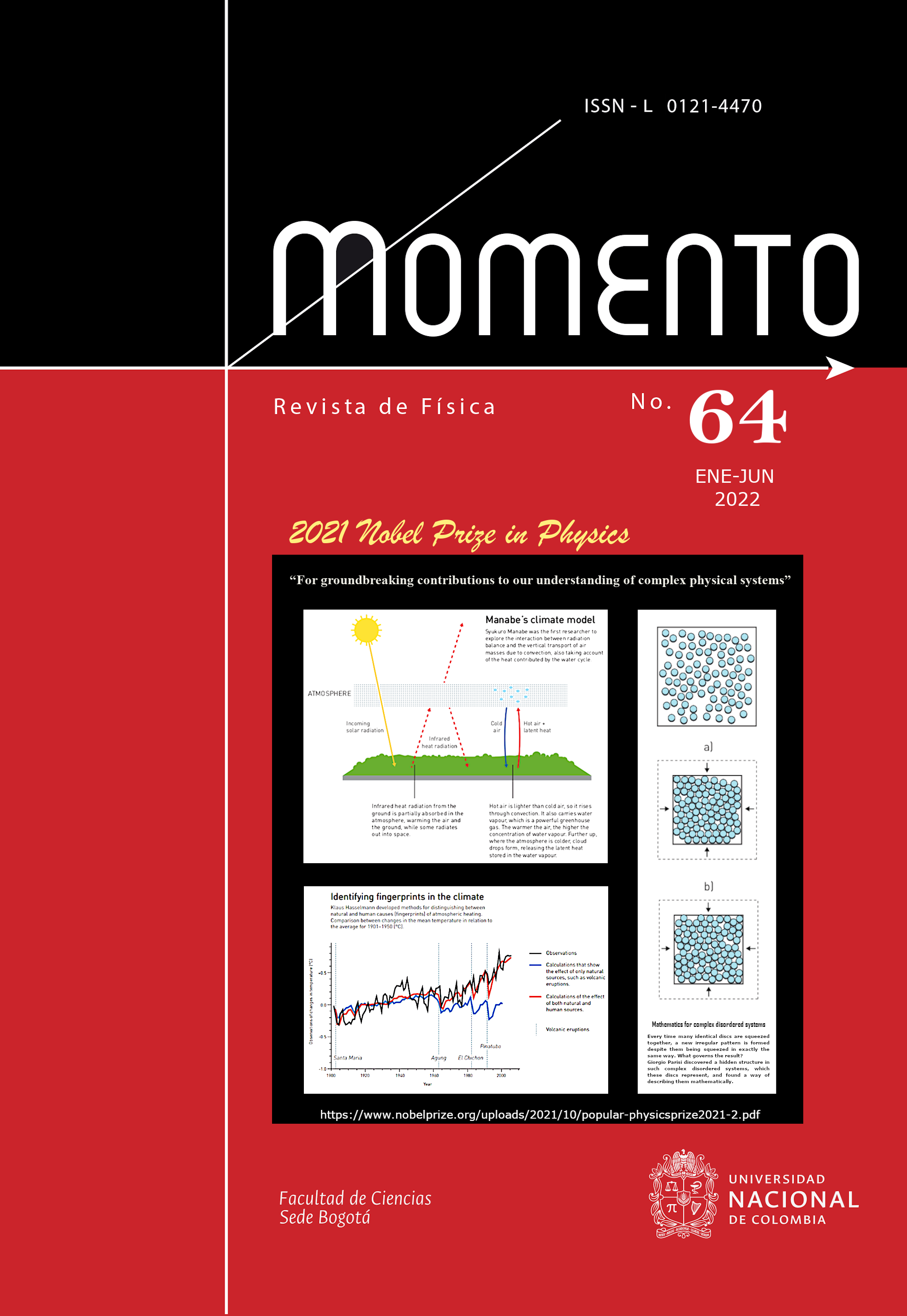Caracterización del grado de complejidad del sistema solar mediante la ley de Zipf/Mandelbrot
Characterization of the degree of complexity of the solar system through Zipf/Mandelbrot’s law
DOI:
https://doi.org/10.15446/mo.n64.97365Keywords:
velocidad orbital, sistema solar, fractal (es)sistema solar, fractal, velocidad orbital (en)
Downloads
La ley de Zipf/Mandelbrot ha permitido caracterizar fenómenos con una organización hiperbólica en las ciencias biomédicas y los lenguajes naturales, entre otros; sin embargo, su aplicación podría extenderse a estudiar características planetarias. Por tanto, el objetivo de esta investigación consiste en aplicar la ley de Zipf/Mandelbrot para caracterizar el grado de complejidad del período orbital, la velocidad orbital media planetaria y la distancia media al sol de los planetas del sistema solar. Para ello, se tomaron los valores del período orbital, la velocidad orbital media y la distancia media al sol de los planetas del sistema solar para evaluar su distribución hiperbólica. Posteriormente, se aplicó la ley de Zipf/Mandelbrot para calcular la dimensión fractal de ambas variables. Se comprobó que los valores del período orbital, la velocidad orbital y la distancia media planetaria se distribuyen jerárquicamente, lo cual permitió calcular los valores de dimensión fractal, que fueron 0.28, 0.88 y 0.42, con coeficientes R2 de 0.92, 0.87 y 0.92, respectivamente. Lo anterior sugiere que la aplicación de la ley de Zipf/Mandelbrot revela la existencia de órdenes matemáticos no descritos en la cinemática celeste al encontrar un mayor grado de complejidad de la velocidad media orbital con respecto a la distancia media planetaria al sol y el período orbital, de donde se puede inferir que los parámetros de análisis de los sistemas planetarios podrían complementarse con este enfoque.
The Zipf/Mandelbrot law has allowed to characterize phenomena with a hyperbolic organization in biomedical sciences and natural languages, among others; however, its application could be extended to study planetary characteristics. Therefore, the objective of this research is to apply the Zipf/Mandelbrot law to characterize the degree of complexity of the orbital period, the planetary mean orbital velocity, and the mean distance to the sun of the planets of the solar system. For this purpose, the values of the orbital period, the mean orbital velocity, and the mean distance of the planets of the solar system to the sun were taken to evaluate their hyperbolic distribution. Subsequently, the Zipf/Mandelbrot law was applied to calculate the fractal dimension of both variables. The values of orbital period, orbital velocity and planetary mean distance were found to be hierarchically distributed, which allowed the fractal dimension values to be calculated. These values were 0.28, 0.88 and 0.42, with R2 coefficients of 0.92, 0.87 and 0.92, respectively. The above suggests that the application of the Zipf/Mandelbrot law reveals the existence of undescribed mathematical orders in the celestial kinematics by finding a greater degree of complexity of the mean orbital velocity with respect to the mean planetary distance to the sun and the orbital period, implying that the analysis parameters of planetary systems could be complemented with this approach.
References
S. T. Piantadosi, Psychon. Bull. Rev. 21, 1112 (2014).
G. Zipf and G. Miller, The Psycho-Biology of Language: An Introdution to Dynamic Philology (MIT Press, 1965).
G. Zipf, Human Behavior and the Principle of Least Effort: An Introduction to Human Ecology (Addison-Wesley Press, 1949).
B. Mandelbrot, Information theory and psycholinguistics: a theory of word frequencies, in Readings in Mathematical Social Science, edited by P. Lazarsfeld, N. Henry, and S. R. Associates (M.I.T. Press, 1966) pp. 350–368.
B. Mandelbrot, WORD 10, 1 (1954).
H. Peitgen, Chaos and Fractals: New Frontiers of Science (Springer, 1992). [7] J. Rodríguez Velásquez, S. Prieto Bohórquez, L. Ortíz Salamanca, A. Bautista Charry, P. Bernal, and N. Avilán Vargas, Rev. Fac. Med. 54, 96 (2006).
J. Burgos, Biosystems 39, 19 (1996).
J. Rodríguez, Rev. Fac. Med. 53, 72 (2005).
A. Koplenig, Corpus Linguistics and Linguistic Theory 14, 1 (2018).
K. Khan, T. Niaz, D. Pecaric, and J. Pecaric, Arab J. Math. S. 26 (2018).
A. Upgren, American Astronomical Society Meeting Abstracts 203, 42.06 (2003).
G. Modestino, INFN (2016).
C. Watson and T. Marsh, Mon. Not. R. Astron. Soc. 405, 2037 (2010).
B. Mancilla, Entretextos 10, 47 (2019).
D. Williams, Planetary fact sheet - metric (2019) (Consultado el 10 de enero de 2021).
Library of Congress. Science Reference Section, Why is pluto no longer a planet? (2019) (Consultado el 10 de enero de 2021).
M. Altaie, Z. Yousef, and A. Al-Sharif, Applying titius-bode’s law on exoplanetry systems (2016).
J. Rodríguez, S. Prieto, C. Correa, Y. Soracipa, N. Chaves, A. Narváez, J. Mojica, M. Aguilera, D. Tapia, and J. Jattin, Infectio 22, 70 (2018).
J. Rodríguez, J. Phys. Conf. Ser. 1160, 012018 (2019).
J. [Rodríguez, S. Prieto, C. Pérez, C. Correa, Y. Soracipa, J. Jattin, and A. David, Infectio 24, 105 (2020).
J. Rodríguez, S. Prieto, and L. Ramírez, Informatics in Medicine Unlocked 15, 100174 (2019).
S. Prieto, J. Rodríguez, C. Correa, and Y. Soracipa, BMC Med Phys 14 (2014).
J. Rodríguez, J. Med. Med. Sci 6, 209 (2015). [25] J. Rodríguez, Inmunología 27, 151 (2008).
How to Cite
APA
ACM
ACS
ABNT
Chicago
Harvard
IEEE
MLA
Turabian
Vancouver
Download Citation
License

This work is licensed under a Creative Commons Attribution-NoDerivatives 4.0 International License.
Those authors who have publications with this journal, accept the following terms:
a. The authors will retain their copyright and will guarantee the publication of the first publication of their work, which will be subject to the Attribution-SinDerivar 4.0 International Creative Commons Attribution License that permits redistribution, commercial or non-commercial, As long as the Work circulates intact and unchanged, where it indicates its author and its first publication in this magazine.
b. Authors are encouraged to disseminate their work through the Internet (eg in institutional telematic files or on their website) before and during the sending process, which can produce interesting exchanges and increase appointments of the published work.




















